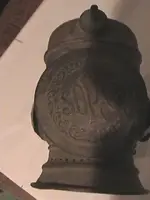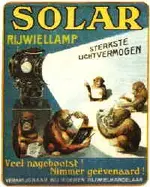In 1897 the American Badger Brass Company advertised the first successful acetylene gas bicycle lamp, called the 'Solar'."
http://home.websolutionswa.com/lamps/miller.html
Then there's this:
"Riding a bicycle at night was a hazardous undertaking before the advent of a source of illumination to light the way. In 1897, the American Badger Brass Company, of Kenosha, WI, advertised the first practical acetylene gas bicycle lamp. Known as the "Solar", it was an invention of intricate design.
A tank at the rear of the lamp was filled with water, and a cup at the bottom contained pellets of calcium carbide. A small spigot allowed water to drip onto the calcium carbide, initiating a chemical reaction that produced flammable acetylene gas. The gas passed upward into a Y-shaped ceramic burner where it was ignited and produced an intense white light. A reflector in the back, and a lens in front further enhanced the light. By controlling the amount of water dripping onto the calcium carbide, the brilliance of the flame could be adjusted. Faceted colored lenses on the sides of the lamp provided a warning to approaching vehicles from the right or left. To prevent the flame from going out when the cyclist hit a bump or pothole, a piece of wire was wrapped around the ceramic jets, which caused it to glow red-hot. If the flame disappeared, the hot wire would re-ignite the gas.
Bicyclers needed to use caution when lighting one of these lamps, as fires were not uncommon. If the acetylene gas escaped its chamber while the lamp was lit, or if excessive pressure built up inside, a serious explosion could result.
These lamps went out of fashion in the late 1930's when battery operated bicycle lights became practical. However, during WWII, when batteries became scarce these old lamps were dusted off and again pressed into service.
Don.......
Source:
http://saukcountyhistory.org/acetelinelamp.html









